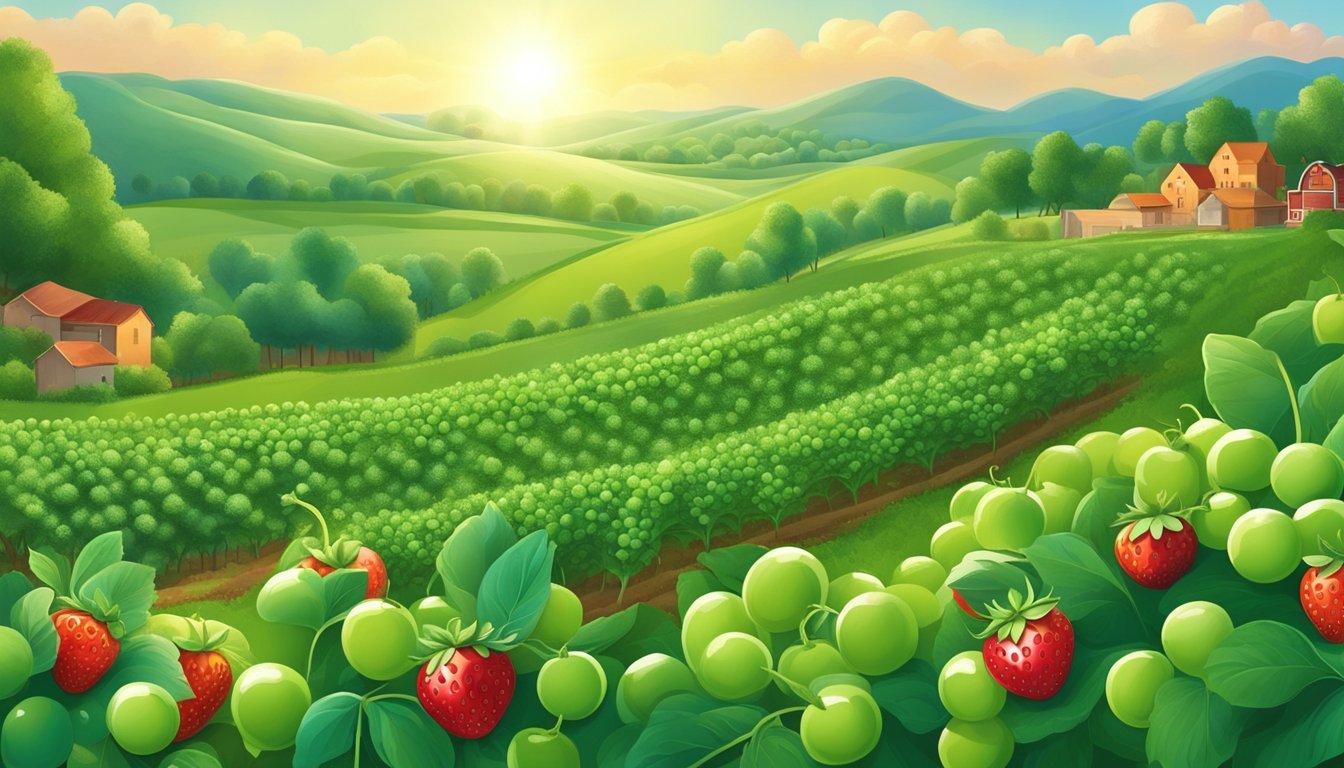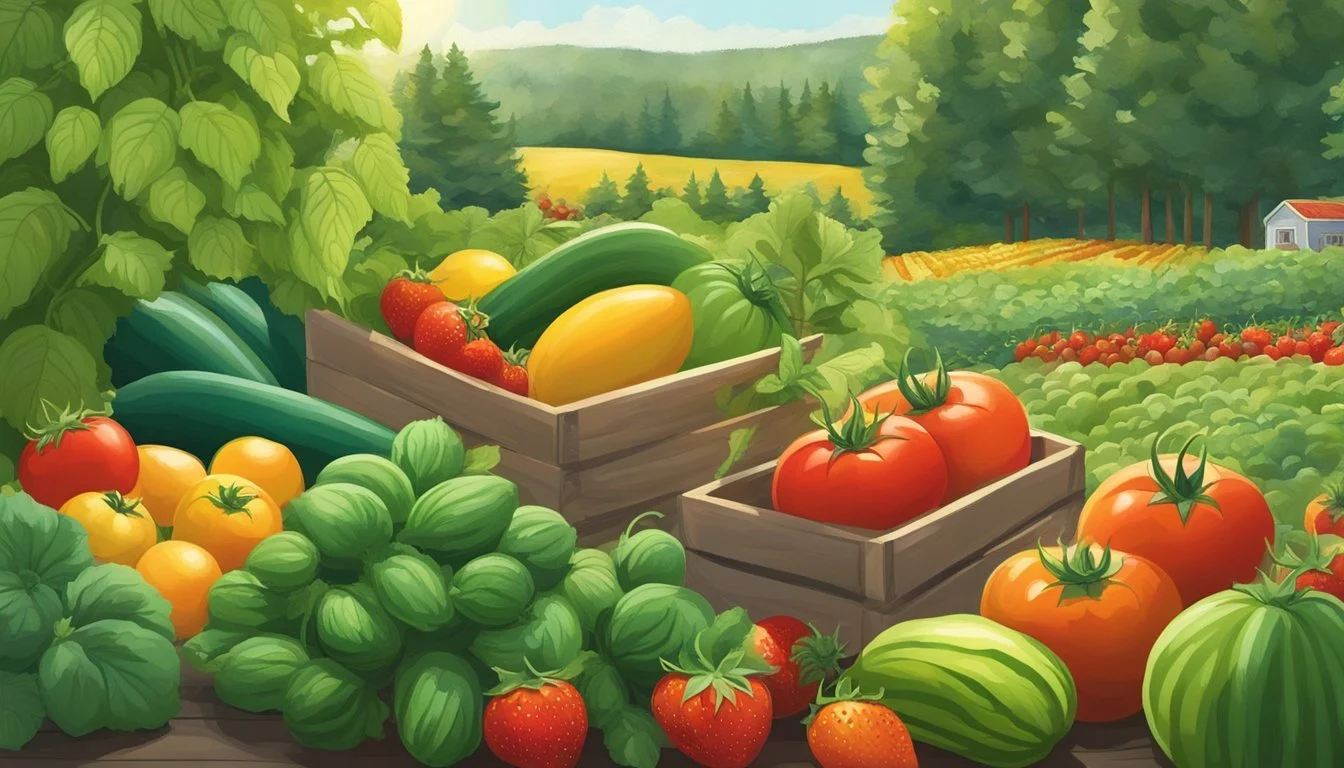Maine Seasonal Fruit & Vegetables in June
Your Fresh Produce Guide
This Article is Part of our Maine Seasonal Fruit & Veg Calendar
June in Maine marks a vibrant period where a variety of fruits and vegetables start to reach their peak, providing an abundance of fresh produce to local markets. During this time, the longer days and warming temperatures contribute to the growth and ripening of numerous crops. Local farmers and gardeners meticulously tend their fields, ensuring that the fruit and vegetables harvested are at their best in terms of flavor and nutrition.
Seasonally, June offers a diverse selection of produce that is both hearty and flavorsome. Vegetables such as leafy greens, radishes, and peas thrive in the mild early summer climate. For fruit lovers, strawberries begin to make their sweet and sought-after appearance in farmers' markets and stands across the state. These seasonal offerings reflect not only the agricultural richness of Maine but also the commitment of its farmers to sustainable and community-supported agriculture.
Residents and visitors alike have the opportunity to indulge in seasonally fresh and locally grown produce. The practice of consuming in-season fruits and vegetables not only supports the local economy, but it also promotes healthier dietary choices, ensuring that consumers can enjoy the food at its nutritional peak. As June progresses, the variety and quantity of available produce will only increase, setting the stage for a summer filled with fresh and wholesome food options.
Advantages of Seasonal Eating
Eating seasonally garners benefits ranging from enhanced nutrition to environmental stewardship. In Maine, local and seasonal eating during the summer months brings its advantages into sharp relief.
Nutritional Benefits
When fruits and vegetables are consumed in season, they are often at their nutritional peak. For instance, produce like strawberries and spinach harvested in June in Maine tend to have higher levels of vitamins and antioxidants. The shorter the time between harvest and consumption, the less likely it is that nutrients will deplete.
Environmental Impact
Opting for seasonal and local produce supports a more sustainable food system. Summer in Maine sees a reduced need for long-distance transportation of fruits and vegetables, which cuts down on fossil fuel consumption and emissions. Furthermore, it reduces the strain on resources including land and water usage, and contributes to fewer instances of soil degradation.
Economic Benefits
Economically, purchasing seasonal produce can be gentler on the wallet. Local farmers' markets in Maine often have competitive prices for their summer harvests since the supply chain is shortened and production costs lower. Consumers benefit from these savings while simultaneously bolstering the local economy.
Maine's Seasonal Climate and Farming Practices
Maine's diverse climate and farming practices are influenced heavily by the transitions between seasons, with preparations peaking in the warmer months. Farmers must adapt to the changing conditions to ensure successful harvests.
Spring Transitions
In Maine, the spring months of April and May are characterized by a gradual increase in temperatures and a reduction in frost occurrences. Farmers take advantage of the warming climate to prepare the fields for planting. During this period, soil management is critical as they ready the ground for June's planting and subsequent growth. The likelihood of late frosts means that some crops are started in greenhouses before being transplanted outdoors.
Summer Preparation
As the season transitions into June and approaches July, Maine experiences an increase in daylight hours and temperature, allowing for a greater variety of crops to be sown directly into the fields. This period is crucial for farmers to establish irrigation systems, manage pests, and optimize plantings for high yield and quality. Strategies such as crop rotation are commonly employed to maintain soil health and prevent disease.
Organic Farming
Organic farming in Maine is growing in popularity as it aligns with sustainable practices and market demands. Farmers often choose to utilize natural fertilizers, like compost and manure, and biological pest control methods to reduce chemicals in their production. Crop diversity, including cover cropping and interplanting, is also a key component of organic farming, providing resilience against unpredictable weather patterns that can lead to varying outcomes from April to July.
June's Harvested Fruits
In June, Maine's fertile lands usher in the beginning of the fruit harvesting season, with a particular abundance of various berries that are ripe for picking.
Berries
Strawberries are typically at the peak of their season in June. They are among the first berries to harvest in Maine, and one can find them fresh at local markets.
Blueberries: While the wild blueberry season generally starts in late July, cultivated varieties may be available at some local farms in June.
Raspberries: Late June might see the start of the raspberry season, depending on the year's weather conditions.
Tree Fruits
June may be slightly early for many tree fruits, which often come into season later in the summer. However, some early varieties of tree fruits may start to be available, particularly at farms utilizing advanced growing techniques to extend the season.
June's Harvested Vegetables
June in Maine is a vibrant time for vegetable harvests. Many vegetables reach their prime, offering fresh and crisp flavors. Gardeners and farmers markets are brimming with a variety of produce.
Leafy Greens
June marks an excellent time for leafy greens. They are some of the first vegetables ready to harvest in Maine's growing season. The selection often includes:
Spinach
Kale
These greens are often celebrated for their crisp texture and are a staple in salads and many dishes requiring fresh, tender leaves.
Root Vegetables
While not as predominant in June, some root vegetables make their appearance. One key player during this month includes:
Beets
They are typically harvested young for their sweetness and tender texture.
Flowering Vegetables
Flowering vegetables are just beginning to show up by June, and gardeners can expect:
Broccoli
Broccoli, a flowering vegetable, is known for its rich green color and is harvested before the flower buds fully open. Steamed or sautéed, broccoli adds both nutrients and a strong visual element to the dinner plate.
In addition to broccoli, June also sees the tail end of asparagus season, a flowering perennial that's much-loved for its unique flavor and texture when harvested young.
Beyond the flowering and leafy vegetables, peas and rhubarb are commonly picked during this time. Peas are sweet and crisp, whether eaten straight from the pod or cooked, while rhubarb offers a tartness that is often used in pies and desserts.
The month of June brings a bountiful selection, each vegetable offering its own distinct taste, texture, and nutritional benefits to Maine's harvest season.
Storing and Preserving June's Produce
In June, Maine offers a bounty of fresh produce that can be enjoyed well beyond their harvest with proper storage and preservation techniques.
Canning and Pickling
Canning provides a way to extend the shelf life of June fruits like strawberries by sealing them in airtight containers. Maine residents often utilize this method for making jams and jellies. Pickling is another preservation method that works well for various vegetables, such as cucumbers and spring peas, turning them into long-lasting pickles and relishes.
Steps for canning fruit:
Prepare the fruit by washing and cutting as needed.
Make a canning syrup or use a pre-prepared mix.
Pack the fruit into canning jars, cover with syrup, and seal.
Steps for pickling vegetables:
Clean vegetables and prepare a vinegar-based pickling solution.
Fill jars with vegetables and cover with the pickling solution.
Process the jars in a hot water bath to seal.
Freezing
Freezing is an excellent option to preserve the flavors of fruits and vegetables. Strawberries can be frozen whole or sliced, and vegetables like peas can be blanched and frozen within hours of harvesting to retain freshness.
Freezing instructions:
Fruit: Wash the fruit, slice if desired, and arrange in a single layer on a baking sheet to freeze before transferring to an airtight container.
Vegetables: Blanch in boiling water, cool in an ice bath, drain, and freeze in airtight containers or bags.
Root Cellaring
Root cellaring involves storing vegetables in a cool, humid, and dark environment, which is ideal for root vegetables available in June such as beets and carrots. This method can keep these vegetables fresh for months.
Root cellaring conditions:
Temperature: Maintain at 32-40°F (0-4°C)
Humidity: Keep at 90-95% to prevent drying out
Ventilation: Ensure proper airflow to prevent spoilage
Maine Produce Availability Calendar
In Maine, June marks the arrival of a variety of fresh produce. They benefit from the region's moderate climate and long daylight hours during early summer.
Vegetables:
Summer onions: Sweet and mild, new summer onions begin to surface.
Lettuce: Crisp and varied in type.
Radishes: Known for their peppery taste and crisp texture.
Spinach: A leafy green packed with nutrients.
Peas: Both snap and shell peas become available.
Fruit:
Strawberries: Iconic for their sweet flavor, Maine strawberries typically start in June.
Herbs:
A selection of fresh herbs like parsley, cilantro, and dill are also ready to be harvested in June.
The table below reflects the produce availability extending from June through the following months, highlighting the rich array of fruits and vegetables found across Maine's farmers' markets and farm stands:
Month Vegetables Fruits June Onions, Lettuce, Radishes, Spinach, Peas Strawberries July Beets, Carrots, Cucumbers Blueberries, Raspberries August Corn, Tomatoes, Zucchini Peaches September Broccoli, Cauliflower Apples, Pears October Pumpkins, Winter squash November-December Storage onions, Potatoes January-March Apples (stored)
Outside of June, Maine continues to offer a plentiful selection of produce each season. Apples, stored from fall, can last well into the winter months. The state's agricultural producers strive to extend the availability of their crops through various methods, ensuring local produce is accessible beyond the traditional growing seasons.
Local Markets and Community Supported Agriculture
In June, Maine's local markets and CSA programs thrive with seasonal produce, offering residents a taste of the freshest local fruits and vegetables. Engaging with these systems supports the local economy and fosters community relationships around sustainable agriculture.
Farmers’ Markets
Farmers' markets in Maine are abundant with seasonal offerings in June. Patrons can expect to find a diverse array of fruits and vegetables grown by local farmers. Some of the produce one might find includes:
Fruits: Strawberries, Cherries
Vegetables: Lettuce, Radishes, Spinach, Peas
Attending a farmers' market not only provides access to fresh, local produce but also the opportunity to meet the farmers who grow the food, learning firsthand about Maine's agricultural offerings and practices.
CSA Programs
Community Supported Agriculture (CSA) programs in Maine represent a method for locals to buy shares of a farm's harvest in advance. In the month of June, CSA members can start receiving an array of produce selected from what is seasonally available. Here's what a share in June might include:
Leafy Greens: Kale, Swiss Chard
Root Vegetables: Beets, Carrots
CSA programs in Maine help mitigate the financial risks for farmers and provide shareholders with fresh produce throughout the growing season. These programs often offer convenient pick-up locations in towns like Portland, Lewiston, and others.
Cooking and Recipes
In June, Maine's seasonal produce offers a variety of fruits and vegetables ideal for fresh, vibrant recipes. Utilizing these ingredients, they can create dishes that are both flavorful and reflective of the region's agricultural offerings.
Seasonal Recipes
During June in Maine, chefs and home cooks can take advantage of an array of locally sourced ingredients to create delightful seasonal recipes.
Snow Peas: Tossed in a light stir-fry or served raw in salads, snow peas add a sweet and crisp element to any dish.
Scallions: Known for their oniony flavor, scallions can be finely chopped and used as garnish or incorporated into savory scones and biscuits.
Strawberries: Peak strawberry season offers the opportunity to make fresh strawberry shortcakes or refreshing smoothies.
The inclusion of seasonal fruit and vegetables not only enhances the flavor of recipes but also supports local agriculture.
Cooking Tips
When cooking with June's seasonal produce in Maine, certain tips can ensure the best results in the kitchen:
For snow peas, minimal cooking time is key to retain their crispness and sweet flavor. Sauté quickly over high heat with a touch of oil and seasonings.
To maximize the flavor of scallions, add the white parts to the dish during cooking and use the green tops as a fresh garnish to maintain their vibrant color and texture.
With strawberries, to preserve their natural sweetness and structure, consider macerating them with a sprinkle of sugar before use to bring out their juices and enhance their flavor in desserts.
Conclusion
In June, Maine offers an abundant selection of seasonal produce that highlights the region's agricultural diversity. During this month, local growers harvest various fruits and vegetables that are considered at their peak in terms of flavor and nutritional value. Community members look forward to the availability of fresh, local goods that signify the beginning of summer’s bounty.
The featured list below underscores the fresh produce that can be commonly found in June:
Fruits: Strawberries are the stars of the season, with their vibrant red hue and juicy texture.
Vegetables: Asparagus spears make their final appearance, while green beans begin to take their place in markets. Leafy greens like lettuce and kale continue to flourish.
Farmers and consumers alike celebrate the June harvest, considering it a fundamental part of the local culture and economy. With the transition into summer, the community relies on these seasonal goods not just for nourishment but also for the continued support of Maine's robust agricultural scene.











